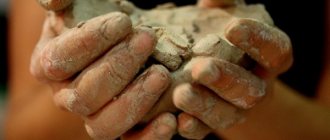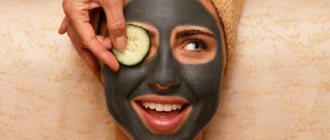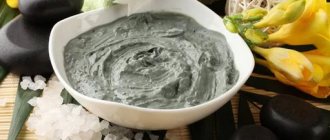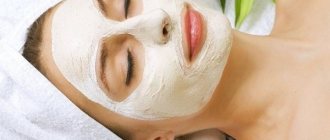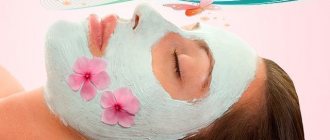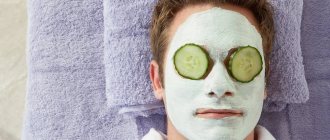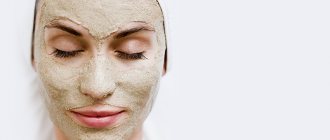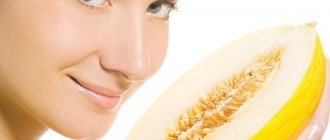Rating: No rating
Today we will talk about a unique natural substance – white clay. Its other name is kaolin, which was given to it at the site of the largest deposit on the planet - the Kaolin province in China. The unique characteristics of white clay are used not only in medicine, but also in cosmetology. Today we will talk about the beneficial properties of white clay for facial skin and offer you recipes for masks that will give you youth and beauty.
Kaolin face masks
Kaolin is the most effective and efficient remedy in the fight for the beauty of the skin.
White clay is the basis not only of cosmetics, but also of baby powders and talcs, as it has an anti-inflammatory effect. Kaolin allows:
- Remove toxins.
- Dry the skin.
- Eliminate oily shine.
- Neutralize the effects of harmful microorganisms.
- Under the influence of kaolin, the skin will become lighter, which is important for age spots.
- Promote face lifting, collagen production.
- The product is especially relevant for acne and pimples. After the first use, inflammation decreases. Clay produces an analgesic effect.
- In combination with other natural ingredients, the effect is enhanced.
Yellow
The composition, in addition to kaolin, includes sodium, sulfur and their compounds, as well as ferric iron and potassium. Yellow clay:
- destroys pathogenic bacteria that abound in oily skin;
- saturates tissues with oxygen;
- restores elasticity when fading;
- reduces the depth of wrinkles;
- softens.
A special feature of applications made from yellow clay is that they are not allowed to dry out on the skin.
Mask for high fat content
To prepare it take:
- kaolin - 2 tsp;
- bee honey, lemon juice, natural apple vinegar - 1 tsp each.
The components are mixed, water is added as needed to achieve sour cream thickness and homogeneity. The application lasts 10 minutes, then wash.
Indications for white clay
White clay face masks are useful in the following cases:
- If you have acne and pimples, masks help treat them.
- Fading facial skin and sagging.
- Expression wrinkles.
- Skin prone to pigmentation.
- Comedones.
You can use face masks for both oily and combination, dry, sensitive skin. A distinctive feature of the product is that it is not a product that can cause allergies.
Rules for preparation and application
White clay, despite its ease of use, requires a number of rules to be followed:
- Before using the mask, the skin must be thoroughly cleaned of cosmetics and impurities and held a little over steam to open the pores.
- To prepare compositions with white clay, use only glass or plastic dishes - metal reduces the beneficial qualities of the clay.
- To prepare the mixture, use only warm water.
- The consistency of the mixture should be like sour cream.
- The prepared mixture should be used immediately and should not be stored.
- Apply the mask simply with your fingers or using a special brush.
- The average time for exposure to white clay masks does not exceed 20 minutes . The exception is dry skin - limit yourself to 10 minutes so as not to dry out.
- The mask must be washed off with warm water.
- After using the mask, be sure to moisturize your skin with cream.
- You should apply white clay to your face no more than once a week . For those with dry skin, one application of the mask every two weeks is enough.
Face masks for oily skin
Pure kaolin composition
It is worth noting that the powder in its pure form allows you to get excellent results, narrowing pores and eliminating inflammation even after the first use. Pour a heaping tablespoon of the product with a small amount of water and stir well. If mineral water is available, it is better to take it. The mixture should resemble thick market sour cream. It is applied to a pre-steamed face and left for 20 minutes.
You can achieve maximum effect by waiting for the mask to dry, which should not be done for dry skin.
To cope with inflammatory processes on the face, you need to replace water with tomato juice.
Aloe+ clay
To prepare the mask, take an aloe leaf, previously kept in the refrigerator on the bottom shelf for several days. This procedure is necessary to concentrate beneficial substances. The juice is squeezed out of the leaf and mixed in equal quantities with mineral water. Clay is added to the ingredients. The mass should be thick and viscous.
Thanks to such a mask, an anti-inflammatory effect will be provided and sebaceous secretion will be controlled.
If your skin is sensitive, it is better to take market milk instead of water.
Kefir mask
This option is suitable for controlling the sebaceous secretion of an oily face. The dry powder is diluted with kefir or natural yogurt. A small amount of chopped herbs and a few drops of lemon juice are added to the resulting slurry.
A whitening effect is achieved, pores are narrowed, and unsightly shine is eliminated. Small wrinkles are smoothed out.
Vodka based masks
To prepare the next mask, see), you need to take agave juice in the amount of a teaspoon. Two parts of vodka are added to it. The thick composition can be diluted with water. The composition produces a rejuvenating effect.
How is it good for the skin?
Clay, regardless of color, is an excellent absorbent that cleanses of toxins, fights pathogenic microbes , and when taken orally, improves the blood formula and activates metabolism. Other effects include:
- whitens;
- tones;
- nourishes;
- rejuvenates.
What explains this action of the rock? One of the inherent properties is ion exchange.
The ions contained in clay bind cations of excess substances that cause the development of dermatological defects.
Clay also consists entirely of a tiny mixture of minerals, which determine its color and determine its beneficial properties and effects. Which clay is suitable for oily skin? Next - about the varieties that help cope with the imperfections of oily skin, and recipes for masks.
Kaolin will cope with wrinkles
You can remove wrinkles by regularly making face masks based on herbs and white clay. Brew lavender, chamomile and sage, taken in equal quantities. The decoction is added to the clay and applied in the usual way.
A gelatin mask is especially beneficial for the skin, as it nourishes it with collagen, stimulating blood circulation. To prepare a mask, take a tablespoon of gelatin and twice as much kaolin. Flavor the mixture with essential oil.
To prepare the composition, gelatin is poured with water and allowed to swell, then the product is dissolved in the microwave or using a water bath. Kaolin and a couple of drops of oil are added to the resulting composition.
The mixture is applied to the skin in the usual way. You need to remove the mask after it dries. A film forms on the skin, which must be carefully removed. Along with it, dead cells and blackheads are removed.
As you can see, white clay face masks will help cope with many problems, you just need to use kaolin correctly and take into account your skin type.
White
This is the main type of rock used in cosmetology to treat oily and problem skin. White clay consists almost entirely of kaolinite, which includes aluminum oxide, silicon dioxide, and water.
It looks like a white powder with a milky yellowish or creamy tint.
Kaolin produces the following effects:
- absorbs sebum;
- dries;
- cleanses pores;
- mattifies;
- additionally - tones, nourishes, smoothes.
Morning cleansing soap
- clay (hereinafter we mean the drug in powder form) - 100 g;
- soda, pharmaceutical boric acid (powder) - 1 tsp of each ingredient.
The products are mixed and transferred to a dry container. In the morning, take a pinch of the mixture, add water, stir to form a paste. Moisten and lather your face with clay, leave for 2 minutes. Then they wash their face, use a toner, then a moisturizing cream for oily skin. This will normalize fat secretion, cleanse pores, and reduce inflammation.
Clay mask for oily skin for nutrition and whitening
To prepare the mask take:
- kaolin - 2 tbsp. l.;
- egg white - 1 pc.;
- water - 3 tbsp. l.;
- lemon juice - 0.5 tsp;
- honey - 1 tsp.
Beat the egg white into a foam, dilute the clay with water, then mix all the ingredients. The mask is smeared on the face and left on for a quarter of an hour.
Mask against inflammation, shine
Includes:
- white clay - 2 tbsp. l.;
- aloe juice - 1 tbsp. l. (or 1 ampoule of extract);
- water - 1 tbsp. l.
A paste of mixed ingredients is applied to the face and left for 15 minutes.
How does the sun affect us?
It is difficult to overestimate the benefits of the sun for the skin - ultraviolet radiation kills bacteria. Thus, it prevents the appearance of acne and accelerates the healing of wounds and scratches. Blood vessels dilate, blood flow to the skin improves - it becomes more elastic, the tone is evened out.
But when there is too much sun, it turns from a friend into a worst enemy - then positive changes in the body are replaced by sharply negative ones. A sign that the body is oversaturated with the sun appears primarily on the skin. Pigment spots and tanning are the first signs. Pigment spots are areas of the skin where melanin production is impaired. They appear after excessive tanning. People with fair skin most often suffer from them.
A protective reaction to ultraviolet radiation - tanning, freckles - does not suit everyone. And not everyone likes it. The fashion for bronze color is passing, more and more people prefer white skin.
To obtain a lightening effect, the skin is treated with various acids. They are weak - so as not to damage the skin, but strong enough to remove the upper cells - those that have been exposed to the sun - and leave the lower cells that are naturally light.
Many products that we usually call “food” have a beneficial effect on the skin. Whitening face masks can be prepared from lemon, parsley, white clay, strawberries, raspberries, cucumber and many other common foods.
Video: How to make a white clay mask at home correctly
The original combination of natural ingredients perfectly cleanses the skin of sebaceous plugs, dries out inflammation, tightens pores and tightens the oval of the face.
White clay is considered one of the most effective cosmetic powders, among other advantages of which is its low cost and ease of use. Already after the first use, you can notice the beneficial effects of kaolin on the skin, and after a course of two months, you can completely eliminate all rashes and post-acne, look much younger and fresher.
Instructions for use of kaolin
Due to its pronounced therapeutic effect, white clay for the face can be found on sale in pharmacies. It usually comes with instructions that describe in detail how to use kaolin for cosmetic purposes. If you skillfully and competently use this natural material, it will not hesitate to have the desired effect on the skin and transform it.
- Indications. White clay is usually used externally for skin diseases and as a cosmetic whitening, cleansing, rejuvenating, and drying agent.
- Pharmacology. Due to its unique ability to form colloids in tissues, kaolin has a powerful enveloping, water-absorbing, light astringent, adsorption effect, prevents the development of inflammation and decay, which allows it to be used at home as an excellent remedy against acne.
- Release form. White powder in various packages.
- Drugs. In pharmacies you can purchase products based on white clay for making homemade cosmetic masks. Bolusal is a combination of sterilized white clay and aluminum hydrate. Boluphen is a mixture of white clay with phenol and formaldehyde. Carbolusal is a preparation made from white clay and activated carbon .
- Properties. Kaolin is aluminum silicate (its hydrous silicate) with an admixture of calcium and magnesium. It is a loose white powder with a grayish or yellowish tint, quite greasy to the touch. It does not dissolve in water or dilute acids. To prepare homemade masks, kaolin is diluted with warm water, forming a colloidal suspension, which dries on the face and turns into a plastic mass that perfectly corrects the contours of the face.
- Production. Pure cosmetic kaolin is obtained by purifying white clay, which is used in the production of earthenware. It is separated from the sand by washing with a solution of hydrochloric acid, which easily removes traces of lime. Kaolin, which is sold in pharmacies, is first sterilized in an oven at a temperature of 160°C.
- Cooking method. White clay should be diluted with warm boiled (filtered or mineral) water. The presence of other liquids in recipes is also possible - milk, medicinal decoctions and infusions of herbs beneficial for the skin (calendula, chamomile, mint, lavender, etc.). The proportions are purely individual and are selected in each case separately. Some people like semi-liquid masks, others - thick ones. Therefore, the ratio of kaolin and water in masks is left to the discretion of home cosmetologists.
- Side effects. It is unlikely that you will find contraindications in the instructions for kaolin. This mineral powder rarely causes allergic reactions. However, in order to avoid annoying misunderstandings, it is still worth checking how your skin reacts to this clay. Lubricate a small area of skin on your wrist with the prepared mask: it is the thinnest and most sensitive there. If redness, rash, burning, itching appear, you will have to abandon kaolin as a cosmetic product.
- Combination with other components. First you have to strictly follow the recommendations in the recipes. Over time, when kaolin facial rejuvenation procedures become regular, you will understand what exactly your skin needs and learn to combine white clay with other components.
- Thermal effect. Kaolin reacts normally to heat, so to prepare cosmetic masks, do not be afraid to heat kefir, honey and oils in a water bath.
- Method of application. Before applying the mask to the skin, it must be steamed over a steam bath and cleaned with a scrub. The mask is applied along massage lines.
- Time of action. 10–15 minutes.
- Wash. White clay can be removed from the face without any problems using foam or gel for washing.
- Frequency of use : 1–2 times a week.
- A course of treatment. 10–12 masks with a break of 1 month.
White clay is an easy-to-use cosmetic product and at the same time one of the most effective.
Masks based on it turn out to be very useful and, in the shortest possible time, allow you to solve the most pressing and relevant skin problems at any time of the year.
Be sure to use any of the many recipes for white clay face masks to enjoy their whitening and rejuvenating effects.
Blue
The blue color comes from silver molecules, which act as an anti-inflammatory and disinfectant. In part, it took over the properties of white clay, as well as blue, which stimulates cell regeneration.
The composition includes cadmium, cobalt, including in the form of salts, silicon, magnesium, iron, and other minerals.
Cleansing mask
The product first opens and then cleanses pores and gets rid of oily shine. First, grind the rice into powder using a coffee grinder. Then take clay and rice powder in equal parts, add water, and dilute it to the consistency of sour cream. The mixture is left for a quarter of an hour and removed with warm water.
Green
Green clay-based care is also one of the most effective for oily skin. Cosmetics based on it deeply cleanses, tightens pores, reduces the production of fat by glands, helps fight acne and inflammation, and also tones, activates blood circulation, eliminates swelling, and is a natural stimulant.
Contains copper and metal salts, divalent iron.
Mask against inflammatory elements
To prepare it take:
- green clay - 10 g;
- lemon, honey - 5 g;
- tea tree oil - 2-3 drops.
The components are mixed, if the mass is thick, add water. Distribute over the skin, leave for 20 minutes, and wash.
Black
The composition includes strontium, quartz, magnesium, calcium, iron and carbon. Black clay improves cellular metabolism better than others. The product is useful for those who have blackheads, comedones, or acne on their face.
By regularly using clay masks for oily skin, you can not only treat, but even completely get rid of rashes.
Anti-blackhead mask
To get rid of comedones, the clay is diluted with water and the paste is applied to the face. After drying slightly, moisten your fingers with water and carefully roll the mass along the massage lines, trying not to stretch the skin. Residues are removed with water. Afterwards they do peeling, for which they take:
- Hercules flakes - 2 tbsp. l.;
- water - 0.1 l.
The flakes are poured with water and allowed to become saturated with moisture. After peeling, wash again.
Acne mask
To reduce the number of rashes, here is a recipe for a homemade anti-inflammatory remedy:
- clay - 1 tsp;
- infusion of string - 2 tbsp. l.
The clay is mixed with a string, the mixture is left on the skin for 15 minutes. After washing, the skin is wiped with infusion from the series.
Parsley masks
Most people think of parsley as just a garnish for dishes, but it can be used for much better purposes. Parsley is rich in vitamins A, C and E. Vitamin A accelerates wound healing and activates cell renewal. Vitamin C acts as an antioxidant and is also necessary for the secretion of collagen, which is responsible for the elasticity of the skin. Vitamin E is also an antioxidant and protects against premature skin aging. Parsley also contains ascorbic and nicotinic acids, which help lighten the skin from age spots.
Very often, parsley is used to combat dark circles, bags under the eyes and wrinkles.
How to prepare whitening face masks from parsley? See the three most effective recipes
Parsley mask:
- chop the parsley leaves and stems and cover with water,
- bring to a boil and cool completely,
- wash your face and do not rinse with water.
This infusion lightens age spots, gives an even skin tone and makes it healthier.
Parsley and dandelion mask:
- finely chop the stems and leaves of parsley and dandelions,
- pour cold boiled water and leave for a day,
- You can wash your face with this infusion every day, especially in the spring.
- After washing, do not immediately rinse with plain water - wait 15 minutes.
Parsley and sour cream mask:
This mask combines the whitening properties of parsley and cucumber, as well as the healing properties of sour cream. For preparation:
- finely chop the parsley and cucumber (you should get a puree),
- add thick sour cream to the puree (the mass should be thick enough to stick to the skin),
- Apply a thick layer to the skin and do not wash off for 20 minutes.
